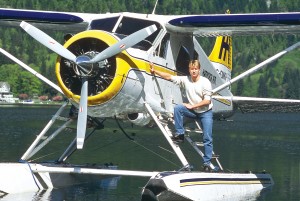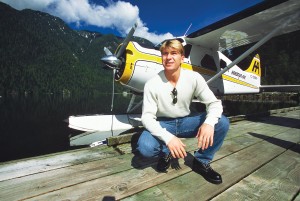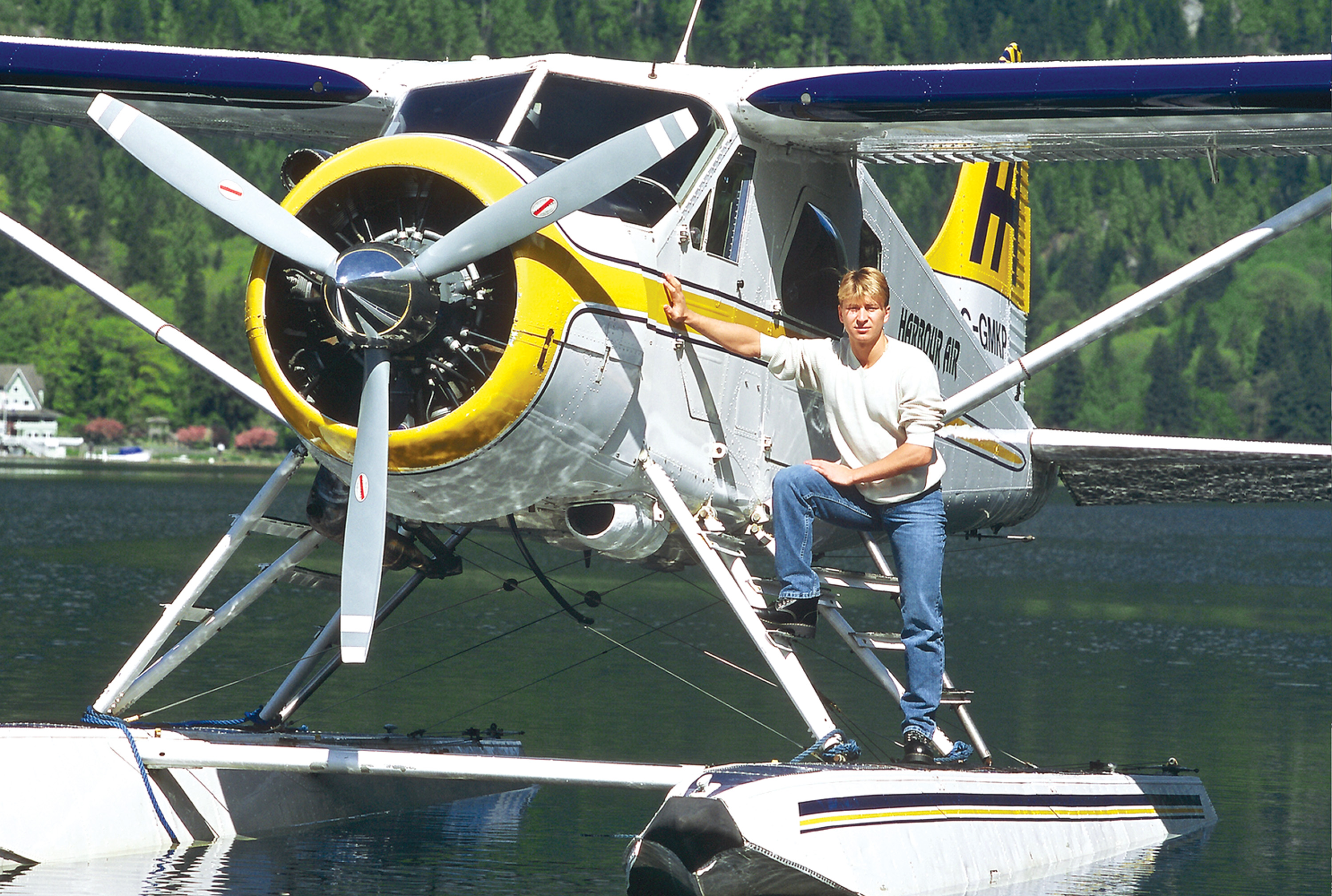By Kathleen Bangs

A floatplane trip in 2002 was Olympic gold medalist Alexei Yagudin’s baptism into the world of general aviation.
Maybe we should’ve been nervous. Less than five minutes out of Vancouver Harbor, on a pristine May morning in 2002, the fresh-faced pilot of our de Havilland floatplane let slip that he wished he’d thought to bring a map, he’d only been flying off of water for a few months, and he’d never actually been to the destination he would soon be craning his neck out the window to find. Ah, those nagging details.
Still, as an airline transport pilot with over 10,000 flight hours—1,000 of those in seaplanes—any concerns were not for me, but for the high-profile cargo in the back seat. Alexei Yagudin, Olympic gold medalist and four-time world champion, had wrapped up the final performance of his popular Canadian Stars on Ice tour the night before in downtown Vancouver. That was a cakewalk compared to the grueling performances that had earned the sport’s biggest male superstar a slew of perfect scores at the 2002 Olympics only a few months earlier in Salt Lake City.
Yet considering all of the flights he’d made all over the globe to win all of those medals, the 22 year old from Russia had never experienced flying in a single-engine airplane. This floatplane trip was his baptism into the world of general aviation. It’s often just these types of flights that first ignite the fire inside somebody to learn to fly. Fingers were crossed that this might turn out to be one of those days.
After meeting Yagudin for the first time, it’s readily apparent that any athlete with the exceptional talent to whip across ice at full afterburner speed and challenge gravity by staying airborne long enough to reel off four-revolution jumps would probably possess the motor skills to be a superb pilot. Besides that, he seemed to be a guy who was game for adventure.
The skies were crisp blue and the seas mirror calm as we ventured north, weaving in and out of the steeply walled green forested canyons that make up the British Columbia coastline and adjoining peninsulas.
“It looks like Scandinavia,” said Yagudin, smiling. “It reminds me of the fjords.”
Although people often tend to think of Moscow upon hearing someone hails from Russia, Yagudin is actually a St. Petersburg native. The city lies close to Scandinavia, and is often called “The Venice of the North” for its labyrinthine network of waterways and canals.
The pilot kept our floatplane steady at 500 feet off the deck, providing a real sense of speed and a spectacular rush of scenery in the windshield. Yagudin loosened his seatbelt to get a better view out the side at the same moment the pilot banked steeply—a critical test.
There’s a chestnut in aviation lore, bandied about in hangar talk when the old and the bold dispense wisdom, that the quickest way to see if a first-time flyer has the “right stuff” is to watch his reaction when the plane makes a sharp bank. If a prospective student tightens up and leans away from the turn, well—as they say—then you have your work cut out for you. If he leans with the turn, he’s comfortable—a natural. Yagudin practically leaned out the window.
Eventually we landed in an isolated cove, save for a big wooden dock to use as a mooring. Upon touchdown, our floats gently sliced through the surface like the proverbial warm knives through butter—it was that smooth. We stepped out to take photos, relax in the warm sun, and maybe drop a fishing line or two in the cold, clear waters.
For the return flight Yagudin said, “I’d like to sit up front if you don’t mind—to see how it’s all done.” And with those words, the seed of a future pilot took hold.
A new challenge
Fast forward: 2005. After being told for three years by his sports management agency that small planes were “just too dangerous to fly,” an eager Yagudin, now 25, was happy to announce an agreement had been reached.
“It was definitely the parachute that sold them,” he said, referring to the ballistic recovery system that is standard equipment on all Cirrus aircraft.
Cirrus Design Corporation, based in Duluth, Minn., took on industry giant Cessna for domination of the single-engine aircraft market and in one decade helped to rejuvenate the sagging market. In the process, Cirrus became Cessna’s most serious rival. In June, Cirrus delivered their two-thousandth new aircraft.
“At first, and like so many people I’ve talked to, I thought that by ‘parachute’ they meant one I would have to wear and use after jumping out of the plane—something I don’t ever want to experience,” laughed Yagudin.
The Cirrus Airframe Parachute System is the standard equipment whole aircraft recovery system frequently referred to as “the chute.”
“I think it’s cool there is this big parachute to use in case of an emergency, because it gives you an extra chance if something goes really wrong,” said Yagudin.
Yagudin said he’s wanted to try flying lessons ever since the floatplane trip, but another problem was that his schedule would never allow it.
“Finally this summer I have some open time I can commit,” he said. “I’m very excited to have a new challenge in front of me.”
Time has always been a scarce commodity for the globetrotting skater. Incredibly gifted at competition, Yagudin racked up dozens of gold medals from every major worldwide event during his eligible career and could arguably go down in history as the best male skater of his era, or perhaps of any generation. Now an active professional skater, he headlines tours across the U.S. and Canada, competes at pro events, takes part in a number of annual television shows, and performs in Europe, Russia and Japan.
Rather than live the high life and squander his wealth as do some young millionaires, the level-headed Connecticut resident, who has called the U.S. home since 1998, has instead wisely chosen to invest his substantial earnings into real estate. He’s already become successful at the venture, as some of his properties have tripled in value over only a few years.
“Right now I own homes, land, condos and apartment buildings in three countries, and I’m looking at two others,” he said. “Most recently I’ve invested in beachfront property in Florida, and I’m considering relocating there in the future. Having the ability to fly around and check on my various properties—and more importantly—scout out new ones, is another reason I’m drawn to flying my own plane.”
Yagudin, who is presently spending skating’s off-season in Russia negotiating a restaurant partnership, is interested in buying an SR22 GTS that he can use for an investment and turn around as part of a lease-back arrangement with an air taxi operator or flight school.
“When I come back to the U.S. in July, I’ll be going to Minnesota for my initial training in the SR20,” he said.
Like many new flight students, Yagudin admits the bookwork can be daunting.
“Well, of course English is not my native language, although I can easily read regular books and magazines,” he said. “I think it would make it easier to have some aeronautical books that could explain the difficult concepts and terms first in Russian, and then translate that to English. I constantly have a laptop computer with me, so to prepare I’ve been studying the airplane’s systems and avionics using the training program CDs.”
To those of us who learned on the traditional “steam gauge” flight instruments, transitioning to glass cockpits became our challenge. But for the uninitiated—like Yagudin—starting from the beginning with glass technology seems to make the entire flight training process easier.
“The first time I got into Cirrus I felt at ease because it reminded me of the inside of my Mercedes sports car; it has that same sort of look and feel and visibility,” he said. “I have GPS in my car and I use it constantly, so as soon as I found out that I’d be navigating in the airplane by GPS that made me comfortable. It was like, ‘Great! Finally something simple for me after all the difficult reading and studying.'”
Growing up in Soviet Russia, Yagudin says there simply was no opportunity for anybody to learn to fly unless they were in the military. Even now something that should be as simple as finding avgas is almost impossible across most of his native country, one so vast that it covers 10 time zones.

Alexei Yagudin is intent on buying a Cirrus SR22 GTS, but says that later he might also have to get a floatplane, because there’s something about flying over water that he really loves.
“When I was young and living and training in Russia, the concept that a regular person could even have the money to buy an airplane was crazy,” he said. “Secondly, we existed under a system that simply did not allow the freedom to fly your own airplane wherever you wanted to go. But after 9/11, when there are so many new restrictions, there is still a huge amount of freedom allowed in flying your own airplane in the U.S., and that’s the other big appeal—to be able to go where I want, and when I want, at my own leisure, and not on somebody else’s timetable.”
Yagudin is looking forward to visiting the Cirrus factory this summer.
“I want to see how the planes are built, and I’m excited to take one flying over the shores of Lake Superior. There is something about flying over water that I really love.” He adds with a big grin, “Who knows, someday I might have to get a floatplane, too.”











